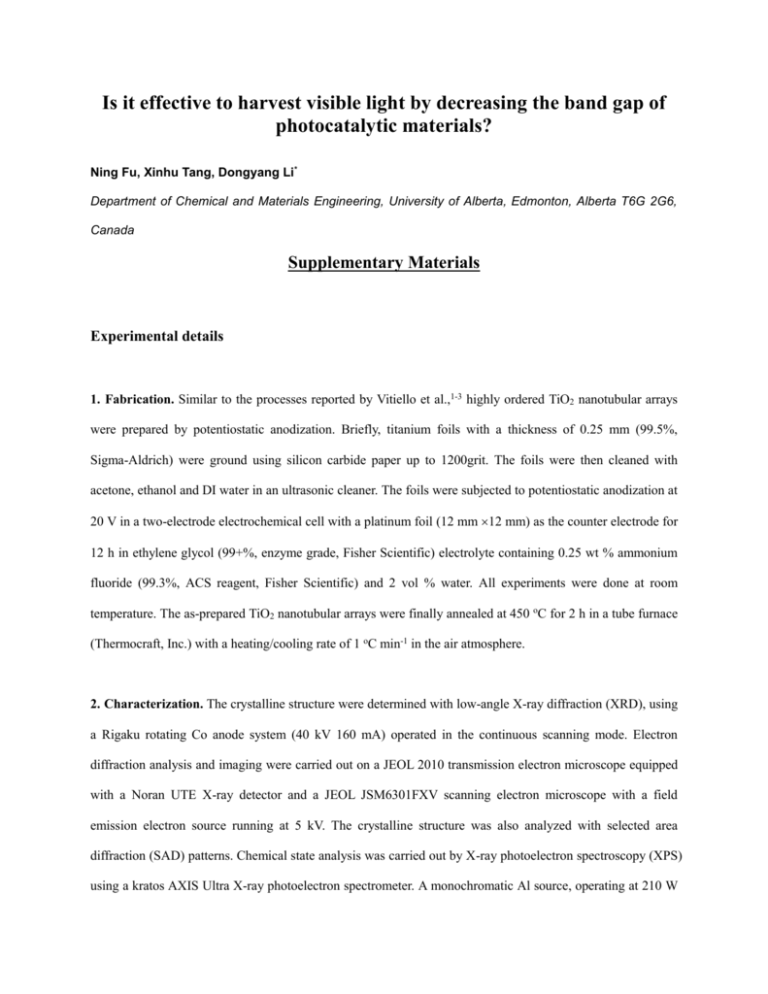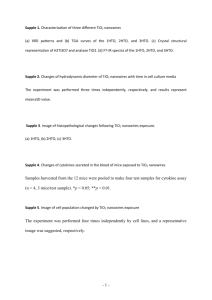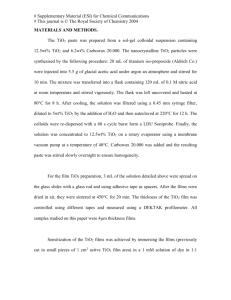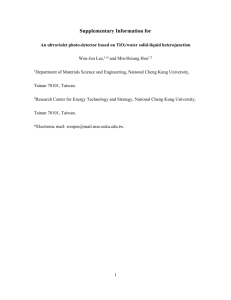Supplementary materials
advertisement

Is it effective to harvest visible light by decreasing the band gap of photocatalytic materials? Ning Fu, Xinhu Tang, Dongyang Li* Department of Chemical and Materials Engineering, University of Alberta, Edmonton, Alberta T6G 2G6, Canada Supplementary Materials Experimental details 1. Fabrication. Similar to the processes reported by Vitiello et al.,1-3 highly ordered TiO2 nanotubular arrays were prepared by potentiostatic anodization. Briefly, titanium foils with a thickness of 0.25 mm (99.5%, Sigma-Aldrich) were ground using silicon carbide paper up to 1200grit. The foils were then cleaned with acetone, ethanol and DI water in an ultrasonic cleaner. The foils were subjected to potentiostatic anodization at 20 V in a two-electrode electrochemical cell with a platinum foil (12 mm 12 mm) as the counter electrode for 12 h in ethylene glycol (99+%, enzyme grade, Fisher Scientific) electrolyte containing 0.25 wt % ammonium fluoride (99.3%, ACS reagent, Fisher Scientific) and 2 vol % water. All experiments were done at room temperature. The as-prepared TiO2 nanotubular arrays were finally annealed at 450 oC for 2 h in a tube furnace (Thermocraft, Inc.) with a heating/cooling rate of 1 oC min-1 in the air atmosphere. 2. Characterization. The crystalline structure were determined with low-angle X-ray diffraction (XRD), using a Rigaku rotating Co anode system (40 kV 160 mA) operated in the continuous scanning mode. Electron diffraction analysis and imaging were carried out on a JEOL 2010 transmission electron microscope equipped with a Noran UTE X-ray detector and a JEOL JSM6301FXV scanning electron microscope with a field emission electron source running at 5 kV. The crystalline structure was also analyzed with selected area diffraction (SAD) patterns. Chemical state analysis was carried out by X-ray photoelectron spectroscopy (XPS) using a kratos AXIS Ultra X-ray photoelectron spectrometer. A monochromatic Al source, operating at 210 W with a pass energy of 20 eV and a step of 0.1 eV, was utilized. All XPS spectra were corrected using the C1s line at 284.6 eV. 3. Response to Light. The EWF of TiO2 nanotubular arrays under illumination of different wavelengths were determined using a Work Function Measurement (WFM) that was provided by the KP Technology Ltd. (Caithness, UK). The illumination was completed with a DC-950 with a light input fiber and a DC regulated illuminator optical chopper. The principle of operation and experimental procedure of the WFM system to measure EWF is described in detail as following: briefly, the principle for this Kelvin system is exquisitely simple, the formation of a capacitor to allow electronic conduction and to detect the charge transfer. In practical operations, the Kelvin capacitor consists of the two plates face to face. By vibrating one plate (Kelvin probe tip) relative to the other (sample surface) at a certain frequency, the current flow is generated in the external circuit. By nullifying current with a backing voltage in series with the vibrating Kelvin probe, the sample EWF can be determined. The system had a high-resolution (<50 μeV) and the probe spacing could be controlled within 40 nm. In the present study, a gold tip with a diameter equal to 0.2 mm was used, and the scanning area was 0.12 mm; the frequency of the Kelvin probe was set as 104.4 Hz. In measurement process, the illumination light was focused on the scanning area by a magnifier. A scanning UV-vis spectrophotometer (U-3010, HITACHI, Japan) was used to collect the reflectance spectra of TiO2 nanotubular arrays over a range of 200-700 nm at a scan speed of 300 nm min-1, using a BaSO4 standard sample as the reflectance standard. The photoelectrochemical properties of the sulfur-doped TiO2 nanotubular arrays were characterized using a three-electrode photoelectrochemical cell with nanotubular arrays as the working electrode, a saturated calomel electrode as the reference, and a platinum foil with dimension of 12 mm 12 mm as the counter electrode in 0.1 mol L-1 KCl solution. The sample was pressed against an O-ring in the photoelectrochemical cell, leaving an area of 1.766 cm2 exposed to the light source through a quartz window. A 150 W fiber optic illuminator (model 190, Dolan-Jenner Industries, Inc.) was used as the light source and desired light achieved by using a whirling turntable having band-pass filters. A scanning potentiostat (model PC4-750, Gamry) was used to perform a potentiodynamic scan and measure the generated current. For the two-beam illumination experiments, the other light souce was employed. The two optical fibers were set as mutually perpendicular, and the light intensity was adjusted through measurement of optical power meter (Analog/Digital handheld power meter, THORLABS, S120VC, with Si sensor, 200-1100 nm, 50 nW-50 mW). The intensity for 390 nm is fixed at 0.056 mW/cm2, and 550 nm is fixed at 0.051 mW/cm2. FIG. S1. (a) FE-SEM top view image of TiO2 nanotubular arrays fabricated at 20 V for 2 h in an ammonium fluoride/ethylene glycol solution. (b) XRD pattern of the fabricated TiO2 nanotubular arrays, (c) high-resolution XPS spectrum of F1s, and (d) UV-Vis DRS spectrum of the fabricated TNAs. Fig. S1a illustrates typical top view of the fabricated TiO2 nanotubular arrays observed under a field-emission scanning electron microscope (FE-SEM). The inner diameter of the nanotubes was in the range of 28~35 nm. The tube wall thickness was about 12 nm. After being annealed at 450 oC for 2h, the fabricated TiO2 nanotubes showed the anatase structure (ICCD PDF 01-0562), confirmed by XRD analysis (Fig. S1b). Fig. S1c shows a high resolution XPS of F 1s doublet of the annealed TNAs. NH4F in the electrolyte appeared not only act as one of key species for anodization but might also result in minor F doping. The weak signal at 688.4 eV could be attributed to doped F atoms in TiO2, that is, substitutional F atoms occupied oxygen sites in the TiO2 crystal lattice to form a solid solution TiO2-xFx.4,5 It should be mentioned that when O2- is replaced by F-, both valence and conduction band tail states are produced.6 The results of DRS (Fig. S1d) confirm that F- doping expanded the visible-light response to about 670 nm with consequently improved absorption in the UV-visible range.5, 7-9 1 2 3 4 5 6 7 8 9 Q. Kang, L.Yang, and Q. Cai, Bioelectrochemistry 74, 62 (2008). N. K. Shrestha, J. M. Macak, F. Schmidt-Stein, R. Hahn, C. T. Mierke, B. Fabry, and P. Schmuki, Angew Chem. Int. Ed. 48, 969 (2009). Y.-Y. Song, F. Schmidt-Stein, S. Berger, and P. Schmuki, Small 6, 1180 (2010). X. Chen, X. Zhang, Y. Su, and L. Lei, Appl. Surf. Sci. 254, 6693 (2008). J. C. Yu, J. Yu, W. Ho, Z. Jiang, and L. Zhang, Chem. Mater. 14, 3808 (2002). L. Kronik and Y. Shapira, Surf. Sci. Rep. 37, 1 (1999). K. Nukumizu, J. Nunoshige, and H. Domen, Chem. Lett. 32, 196 (2003). A. Hattori and H. Tada, J. Sol-Gel Sci. Technol. 22, 47 (2001). D. Li, H. Haneda, and N. Ohashi, Chem. Phys. Lett. 401, 579 (2005).







